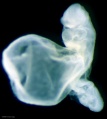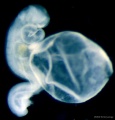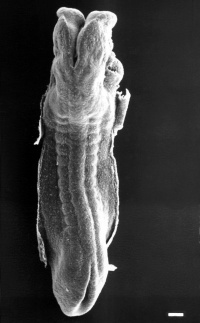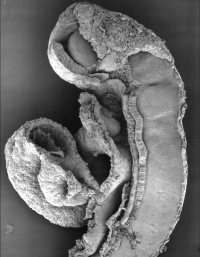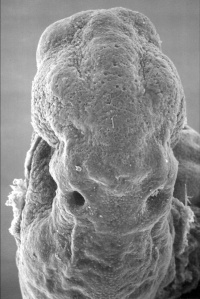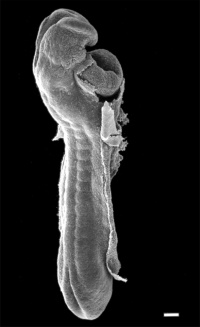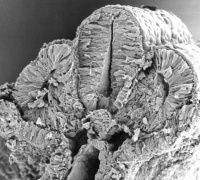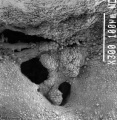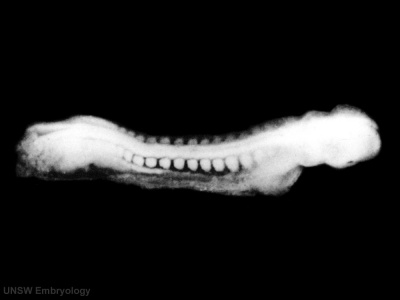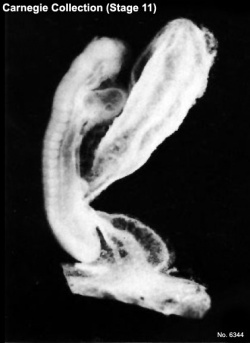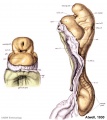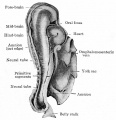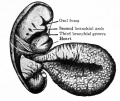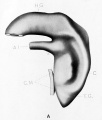Carnegie stage 11
| Embryology - 27 Apr 2024 |
|---|
| Google Translate - select your language from the list shown below (this will open a new external page) |
|
العربية | català | 中文 | 中國傳統的 | français | Deutsche | עִברִית | हिंदी | bahasa Indonesia | italiano | 日本語 | 한국어 | မြန်မာ | Pilipino | Polskie | português | ਪੰਜਾਬੀ ਦੇ | Română | русский | Español | Swahili | Svensk | ไทย | Türkçe | اردو | ייִדיש | Tiếng Việt These external translations are automated and may not be accurate. (More? About Translations) |
Introduction
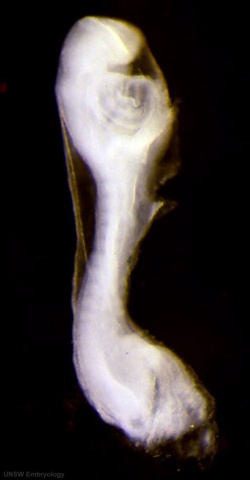
|
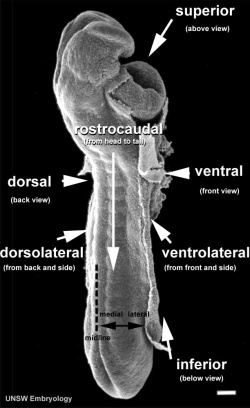
|
FactsWeek 4, 23 - 26 days, 2.5 - 4.5 mm, Somite Number 13 - 20 Gestational Age GA - week 6 Summary
This early week 4 embryonic stage shows key features of heart tube and neural plate to tube development. The embryo is still transparent enough to view the underlying somite and transverse septum development.
The embryo is still quite small and is comparable in size to the external yolk sac. There are a number of different images and resources available for this embryonic stage including: |
| Lateral (right) view of embryo |
Features
rostral neuropore closing, forebrain, neural tube in region of developing spinal cord, somites, caudal neuropore, connecting stalk, amnion
Identify: heart, rostral (cranial, anterior) neuropore closing, forebrain, neural tube in region of developing spinal cord, somites, caudal neuropore, connecting stalk, amnion
| Week: | 1 | 2 | 3 | 4 | 5 | 6 | 7 | 8 |
| Carnegie stage: | 1 2 3 4 | 5 6 | 7 8 9 | 10 11 12 13 | 14 15 | 16 17 | 18 19 | 20 21 22 23 |
- Carnegie Stages: 1 | 2 | 3 | 4 | 5 | 6 | 7 | 8 | 9 | 10 | 11 | 12 | 13 | 14 | 15 | 16 | 17 | 18 | 19 | 20 | 21 | 22 | 23 | About Stages | Timeline
Bright Field

|
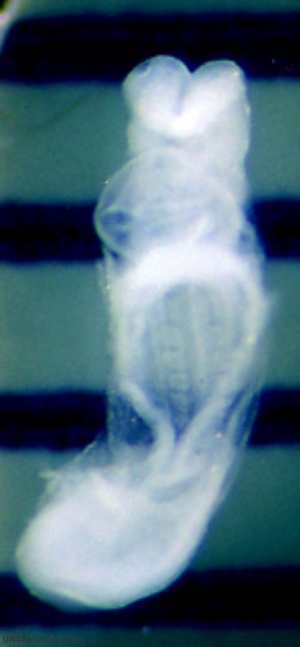
|
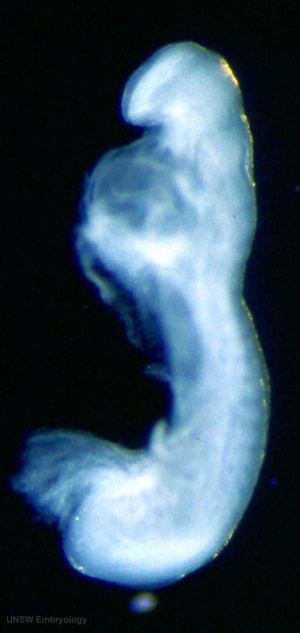
|
| Embryo dorsal view | Embryo ventral with 1 mm scale bar | Embryo lateral view |
Select image below to open full-size.
- Stage 11 Images: BF1 - dorsal view | BF2 - lateral view | BF3 - ventral with scale bar | BF4 - ventral view | BF5 - lateral view | BF6 - ventral view | BF7 - Kyoto embryo | BF8 - ventral head | BF9 - ventral head | BF10 - dorsal neural | BF11 - ventral embryo and yolk sac | Scanning EM embryo | Carnegie stage 11
Scanning EM
| Cranial End of Embryo | |
|---|---|

|

|
Buccopharyngeal Membrane
The degenerating buccopharyngeal membrane is shown at the floor of the stomodeum.
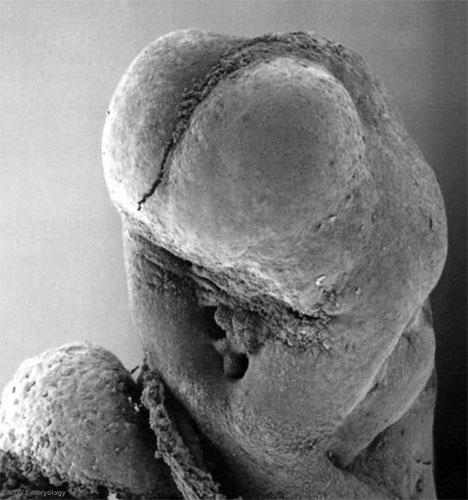
|
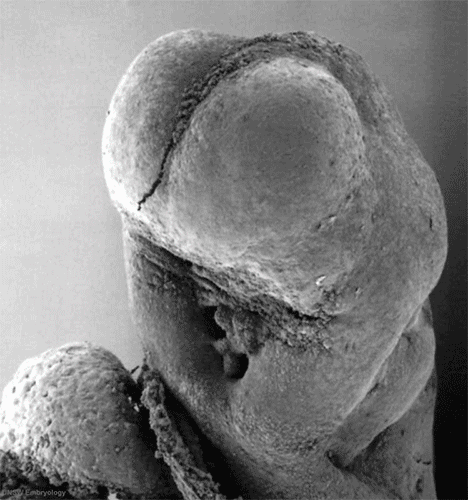
|
Neuropores
Neural Crest

|
Scanning EM showing low power image of whole embryo and region shown in detail box right of neural crest cells.
|
Image Source: Scanning electron micrographs of the Carnegie stages of the early human embryos are reproduced with the permission of Prof Kathy Sulik, from embryos collected by Dr. Vekemans and Tania Attié-Bitach. Images are for educational purposes only and cannot be reproduced electronically or in writing without permission.
Kyoto Collection
View: This is a left dorsolateral view of embryo. Amniotic membrane removed.
View: Transverse section (scale bar 0.5 mm)
Image source: The Kyoto Collection images are reproduced with the permission of Prof. Kohei Shiota and Prof. Shigehito Yamada, Anatomy and Developmental Biology, Kyoto University Graduate School of Medicine, Kyoto, Japan for educational purposes only and cannot be reproduced electronically or in writing without permission.
Carnegie Collection
| iBook - Carnegie Embryos | |
|---|---|
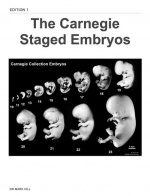
|
|
| Carnegie Collection - Stage 11 | ||||||||||
|---|---|---|---|---|---|---|---|---|---|---|
| Serial No. | Pairs of somites | Size (mm) | Grade | Fixative | Embedding Medium | Plane | Thinness (µm) | Stain | Year | Notes |
| 12 | 14 | E, 2.1 Ch, 13 | Poor | P | Transverse | 10 | Al. carm. | 1893 | ||
| 164 | 18 | E, 3.5 Ch, 14 | Good | Formalin | P | Transverse | 20 | Al. carm. | 1913 | |
| 318 | 13/14 | E, 2.5 Ch, 16 | Good | P | Transverse | 25 | Al. carm. | 1905 | ||
| 470 | 17 | E, 4.3 Ch, 16 | Good | Formalin | P | Transverse | 10 | Al. carm. . | 1910 | |
| 779 | 14 | E, 2.75 | Good | C | Transverse | 15 | Al. coch. | 1913 | Dysraphism. Noted by Dekaban (1964)[1] | |
| 1182b | E, 3 Ch, 15x12x5 | Good | Formalin | ? | Transverse | 20 | Al. carm. | 1915 | ||
| 2053 | 20 | E, 3.1 Ch, 12 | Exc. | Formalin | P | Transverse | 10 | Al. coch. | 1918 | Most advanced in group. Ag added to slide 2 Monographs by Davis (1923)[2] and Congdon (1922)[3] |
| 4315 | 17 | E, 4.7 Ch, 23x10.4X11 | Excellent | ? | C-P | Transverse | 10 | I.H. & E. | 1923 | Univ. Chicago No. 951. Wen (1928)[4] |
| 4529 | 14 | E, 2.4 Ch, 21 | Excellent | Formalin | P | Transverse | 10 | Al. coch, or. G. | 1924 | Heuser (1930)[5] |
| 4783 | 13 | E, 2.3 | Fair | ? | ? | Transverse | 5 | I.H. | 1924 | Wallin (1913)[6] |
| 4877 | 13 | E, 2 Ch, 15 | Good | Formalin | P | Transverse | 15 | Al. coch. | 1925 | |
| 5072 | 17 | E, 3 | Good | Formalin | P | Transverse | 10 | (Stain - Haematoxylin Eosin) | 1925 | Tubal Type specimen. Atwell (1930)[7] |
| 6050 | 19/21 | E.,3 Ch, 10 | Good | Formalin | C-P | Coronal | 10 | Al. coch. | 1930 | Advanced |
| 6344 | 13 | E, 2.5 Ch, 17 | Excellent | Formalin | C-P | Transverse | 6 | Al. coch. | 1931 | Least advanced in group |
| 6784 | 17 | E, 5 Ch, 16 | Excellent | Formalin | C-P | Transverse | 6 | I.H, or. G. | 1933 | |
| 7358 | 16 | E, ? Ch, 15 | Poor | Alc, formol | p | Oblique | 25 | (Stain - Haematoxylin Eosin) | 1936 | |
| 7611 | 16 | E., 2.4 Ch., 12 | Excellent | Bouin | C-P | Transverse | 8 | (Stain - Haematoxylin Eosin) | 1938 | |
| 7665 | 19 | E., 4.36 | Excellent | ? | C-P | Transverse | 6 | 1939 | Univ. Chicago No. H 1516 | |
| 7702 | 17 | E, 3.7 Ch., 14 | Good | Formalin | C-P | Transverse | 10 | Al. coch. | 1940 | Returned to B M Patten |
| 7851 | 13 | E., 4.3 Ch, 18 | Excellent | Formalin | C-P | Transverse | 8 | (Stain - Haematoxylin Eosin) | 1940 | Slightly injured |
| 8005 | 16/17 | E, 3 | Excellent | Bouin | C-P | Transverse | 8 | (Stain - Haematoxylin Eosin) | 1942 | Tubal |
| 8116 | 17 | E, 14 Ch.. 17 | Good | Formalin | p | Sagittal | 8 | Azan | 1953 | |
| 8962 | 15 | E, 1.55 | Good | ? | * | Sagittal | ? | ? | 1952 | Tubal Univ. Chicago No. H 810 |
Abbreviations
| ||||||||||
References
| ||||||||||
Historic Embryology
Harvard Collection No. 714
- Harvard Collection No. 714 described by Bremer, J. L. 1906. Description of a 4-mm Human Embryo. Amer. J. Anat., 5, 459-480.
Pfannenstiel III
Keibel Collection Pfannenstiel III
Keibel F. and Elze C. Normal Plates of the Development of the Human Embryo (Homo sapiens). (1908) Vol. 8 in series by Keibel F. Normal plates of the development of vertebrates (Normentafeln zur Entwicklungsgeschichte der Wirbelthiere) Fisher, Jena., Germany. Shown as Embryo No. 6 (Plate 1 fig. Vr. and Plate 2 fig. Vv.). Text-Book of Embryology (1921) Fig. 84
Low A. Description of a human embryo of 13-14 mesodermic somites. (1908) J Anat Physiol. 42(3): 237-51. PMID 17232769 | PMC1289161
Chicago Collection H951
Wen IC. The anatomy of human embryos with seventeen to twenty-three pairs of somites (1928) J. Comp. Neural., 45: 301-376. H951 is a University of Chicago Collection 17 somite embryo.
Carnegie Collection
Davis CL. Description of a human embryo having twenty paired somites. (1923) Carnegie Instn. Wash. Publ. 332, Contrib. Embryol., 15: 1-51.
Heuser CH. A human embryo with 14 pairs of somites. (1930) Carnegie Instn. Wash. Publ. 414, Contrib. Embryol., Carnegie Inst. Wash. 22:135-153.
Atwell WJ. A human embryo with seventeen pairs of somites. (1930) Contrib. Embryol., Carnegie Inst. Wash. Publ. 407, 21: 1-24.
Watt JC. Description of two young twin embryos with 17-19 paired somites. (1915) Contrib. Embryol., Carnegie Inst. Wash. 2: 15-54.[1]
Histology
Human embryo (CRL 4.2 mm) Blechschmidt Collection
Stage 11 histology links: optic pit | optic vesicle-hindbrain | neural tube roof plate 1 | neural tube roof plate 2
Events
- cardiovascular - heart beating and peristaltic flow begins.[2]
- hearing - at 16 somites the otic pit is formed and lies dorsal to the second pharyngeal groove (cleft).[3]
- vision - right and left optic primordia meet at the optic chiasma forming a U-shaped rim.[4]
- smell - the nasal epiblastic thickening appears.[5] Stages Description
- gastrointestinal tract - cloacal membrane is located on the ventral surface of the caudal part of the body wall, in a central oval depression.
- meninges - (spinal cord) - migration of cells from the somites has increased in embryos and the neural crests have undergone rapid development. Extending ventrally from the neural crests, and appearing to be continuous with them, is a single layered strand of cells. This extends along the lateral edge of the neural tube and contains cells which are more flattened and elongated than those migrating from the somite.[6]
References
- ↑ Watt JC. Description of two young twin embryos with 17-19 paired somites. (1915) Contrib. Embryol., Carnegie Inst. Wash. 2: 15-54.
- ↑ de Vries PA. and Saunders JBdeCH. Development of the ventricles and spiral outflow tract in the human heart. (1962) Carnegie Instn. Wash. Publ. 621, Contrib. Embryol., 37: 87-114.
- ↑ Bartelmez GW. and Evans HM. Development of the human embryo during the period of somite formation, including embryos with 2 to 16 pairs of somites. (1926) Contrib. Embryol., Carnegie Inst. Wash. Publ. 362, 17: 1-67.
- ↑ Pearson AA. (1980). The development of the eyelids. Part I. External features. J. Anat. , 130, 33-42. PMID: 7364662
- ↑ Bossy J. Development of olfactory and related structures in staged human embryos. (1980) Anat. Embryol., 161(2);225-36 PMID 7469043
- ↑ Sensenig EC. The early development of the meninges of the spinal cord in human embryos. (1951) Contrib. Embryol., Carnegie Inst. Wash. Publ. 611.
Additional References
Mizoguti H. A fifteen-somite human embryo. (1989) Adv Anat Embryol Cell Biol. 116:1-102. PMID: 2610025
Müller F & O'Rahilly R. (1986). The development of the human brain and the closure of the rostral neuropore at stage 11. Anat. Embryol. , 175, 205-22. PMID: 3826651
- Carnegie Stages: 1 | 2 | 3 | 4 | 5 | 6 | 7 | 8 | 9 | 10 | 11 | 12 | 13 | 14 | 15 | 16 | 17 | 18 | 19 | 20 | 21 | 22 | 23 | About Stages | Timeline
Cite this page: Hill, M.A. (2024, April 27) Embryology Carnegie stage 11. Retrieved from https://embryology.med.unsw.edu.au/embryology/index.php/Carnegie_stage_11
- © Dr Mark Hill 2024, UNSW Embryology ISBN: 978 0 7334 2609 4 - UNSW CRICOS Provider Code No. 00098G










